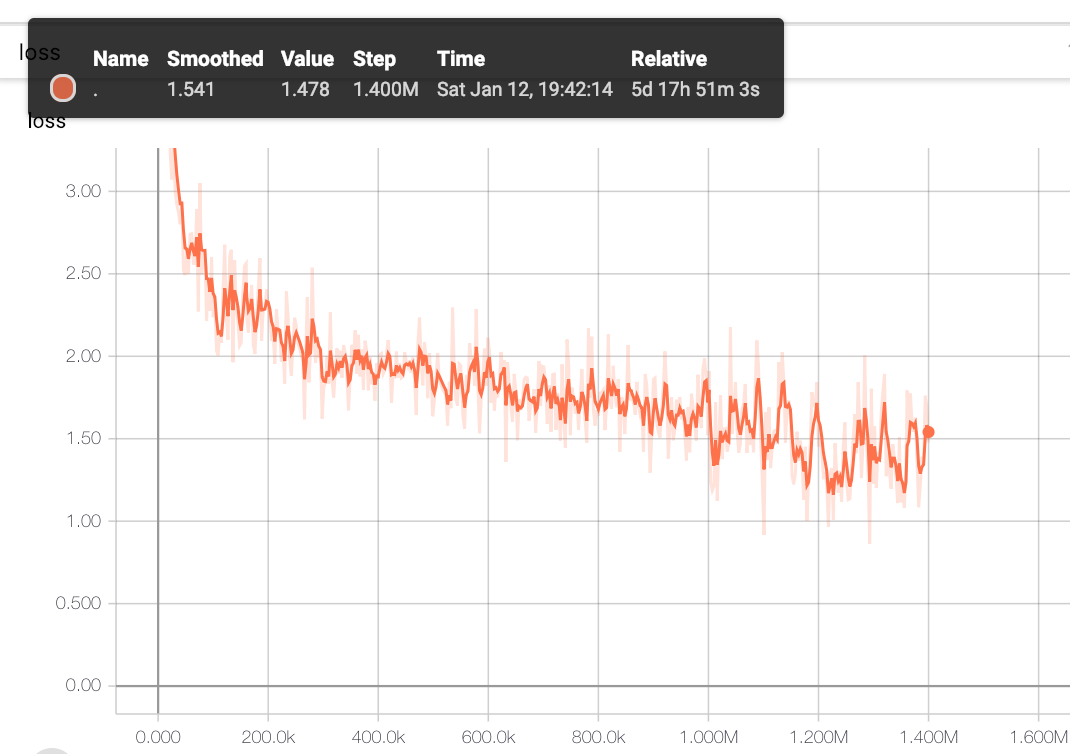yoheikikuta / Bert Japanese
Labels
Projects that are alternatives of or similar to Bert Japanese
BERT with SentencePiece for Japanese text.
This is a repository of Japanese BERT model with SentencePiece tokenizer.
To clone this repository together with the required BERT and WikiExtractor:
git clone --recurse-submodules https://github.com/yoheikikuta/bert-japanese
Pretrained models
We provide pretrained BERT model and trained SentencePiece model for Japanese text.
Training data is the Japanese wikipedia corpus from Wikimedia Downloads.
Please download all objects in the following google drive to model/ directory.
Loss function during training is as below (after 1M steps the loss function massively changes because max_seq_length is changed from 128 to 512.):

***** Eval results *****
global_step = 1400000
loss = 1.3773012
masked_lm_accuracy = 0.6810424
masked_lm_loss = 1.4216621
next_sentence_accuracy = 0.985
next_sentence_loss = 0.059553143
Finetuning with BERT Japanese
We also provide a simple Japanese text classification problem with livedoor ニュースコーパス.
Try the following notebook to check the usability of finetuning.
You can run the notebook on CPU (too slow) or GPU/TPU environments.
The results are the following:
- BERT with SentencePiece
precision recall f1-score support
dokujo-tsushin 0.98 0.94 0.96 178
it-life-hack 0.96 0.97 0.96 172
kaden-channel 0.99 0.98 0.99 176
livedoor-homme 0.98 0.88 0.93 95
movie-enter 0.96 0.99 0.98 158
peachy 0.94 0.98 0.96 174
smax 0.98 0.99 0.99 167
sports-watch 0.98 1.00 0.99 190
topic-news 0.99 0.98 0.98 163
micro avg 0.97 0.97 0.97 1473
macro avg 0.97 0.97 0.97 1473
weighted avg 0.97 0.97 0.97 1473
- sklearn GradientBoostingClassifier with MeCab
precision recall f1-score support
dokujo-tsushin 0.89 0.86 0.88 178
it-life-hack 0.91 0.90 0.91 172
kaden-channel 0.90 0.94 0.92 176
livedoor-homme 0.79 0.74 0.76 95
movie-enter 0.93 0.96 0.95 158
peachy 0.87 0.92 0.89 174
smax 0.99 1.00 1.00 167
sports-watch 0.93 0.98 0.96 190
topic-news 0.96 0.86 0.91 163
micro avg 0.92 0.92 0.92 1473
macro avg 0.91 0.91 0.91 1473
weighted avg 0.92 0.92 0.91 1473
Cautions when using the model as a sentence generation model
The model expects lowercase input and the tokenizer is assumed to be used with do_lower_case=True option, but the special tokens such as [CLS] are registered in uppercase characters.
Therefore, when we put "[CLS] I am ..." it into the tokenizer as a raw string, the tokenizer first makes it lowercase ("[cls] i am ...") and then cannot interpret "[cls]" as the special token, which causes problems.
If you wanna use the model as a sentence generation model, follow from these steps (sorry, it's a little bit confusing):
- keep special tokens (such as
[CLS]or[SEP]) uppercase - make original input sentences lowercase manually (e.g.,
"i am ...") - join them together (e.g.,
"[CLS] i am ...") and put it into the tokenizer withdo_lower_case=Falseoption - put the obtained tokens into the model
Pretraining from scratch
All scripts for pretraining from scratch are provided. Follow the instructions below.
Environment set up
Build a docker image with Dockerfile and create a docker container.
docker build -t bert-ja .
docker run -it --rm -v $PWD:/work -p 8888:8888 bert-ja
Data preparation
Data downloading and preprocessing. It takes about a few hours on GCP n1-standard-16 (16CPUs, 60GB memories) instance.
python3 src/data-download-and-extract.py
bash src/file-preprocessing.sh
The above scripts use the latest jawiki data and wikiextractor module, which are different from those used for the pretrained model. If you wanna prepare the same situation, use the following information:
- bert-japanese: commit
074fe20f33a020769091e1e5552b33867ccbd750 - dataset:
jawiki-20181220-pages-articles-multistream.xml.bz2in the Google Drive - wikiextractor: commit
1e4236de4237d0a89d0ad7241505d73ee7e23517
Training SentencePiece model
Train a SentencePiece model using the preprocessed data. It takes about two hours on the instance.
python3 src/train-sentencepiece.py
Creating data for pretraining
Create .tfrecord files for pretraining.
For longer sentence data, replace the value of max_seq_length with 512.
for DIR in $( find /work/data/wiki/ -mindepth 1 -type d ); do
python3 src/create_pretraining_data.py \
--input_file=${DIR}/all.txt \
--output_file=${DIR}/all-maxseq128.tfrecord \
--model_file=./model/wiki-ja.model \
--vocab_file=./model/wiki-ja.vocab \
--do_lower_case=True \
--max_seq_length=128 \
--max_predictions_per_seq=20 \
--masked_lm_prob=0.15 \
--random_seed=12345 \
--dupe_factor=5 \
--do_whole_word_mask=False
done
Pretraining
You need GPU/TPU environment to pretrain a BERT model.
The following notebook provides the link to Colab notebook where you can run the scripts with TPUs.
How to cite this work in papers
We didn't publish any paper about this work.
Please cite this repository in publications as the following:
@misc{bertjapanese,
author = {Yohei Kikuta},
title = {BERT Pretrained model Trained On Japanese Wikipedia Articles},
year = {2019},
publisher = {GitHub},
journal = {GitHub repository},
howpublished = {\url{https://github.com/yoheikikuta/bert-japanese}},
}
